Stay & Walks
No Day-To-Day Itinerary
The stay is designed as a wild nature living experience. Our local landscape walks are part of the stay. We walk in the area around the camp. And are escorted and guided by our ecolodge staff team.
We’d like to underline that we don’t list any itinerary breakdowns for the walks. Because we can’t work like that. For overview we will list a few keywords about walks.
WALKS - KEYWORDS :
- Usually two walks per day. In the morning and in the evening
- The morning walk. Rule of thumb is a forest walk after breakfast. Ending before 11.30 am
- Afternoon walks will start after 4.30 pm. We will avoid walking in the hottest mid-day hours of the day
- Each walk takes about 1.5 hour
- Walks are quite standard, quite the same but also unique, every time
- Walks would typically be slightly different from day to day
- The walk route depends on what we decide is best on the particular day and in the particular moment
- Walks have no physical target, they are more about moving around
- Walks are typically leisurely. More than exhausting
- We aim to concentrate on bird watching and all sorts of small details
- The walks are enjoyable and exciting. Sometimes they are partly social walks, at other times we are silent, quiet and nature focused
- Ecolodge host- and manager Kamal is a capable and experienced bird- and naturalist guide. Always with a bird-book and binocular in his hands
- Walks are planned at our discretion and may be shorter, changed or cancelled
- Walks depend on natural factors such as the weather and the movement of wildlife, especially elephants
IDEAL LENGTH OF STAY
On a 2 – 3 – 4 night stay one experiences an interesting palate of jungle living and walking. As indicated below. We believe that a 3-night stay comes with an ideal balance of relaxed time to get in tune with the nature environment. Enjoy some jungle time in the camp. And do some trips on foot with the team in the local landscape.


Arrival & Departure days
ON ARRIVAL DAY
Get to the lodge early afternoon for lunch or tea. Acclimatise to your surroundings.
The earliest check-in / arrival time at the lodge is 13 pm.
Afternoon :
In the late afternoon around 4.30 pm our tracker team will take you on a walk in the vicinity of the lodge. You will be introduced to the locality, the landscape, you may pass elephant tracks, see some birds and insects and will be introduced to the wild nature of this remote buffer zone area, north of Yala National Park.
Evening :
When returning to the lodge around 6 pm, get ready for the evening. Before night falls hurricane lamps will be placed outside your tent. Enjoy the jungle setting with a sundowner served with local bites.
Seasonally elephants can appear in the evening before sunset. In the period June – October elephants are observed more frequently near the lodge. Elephants are always on the move, and they come and go in the area around Tree Tops Jungle Lodge. Elephants are primarily nocturnal and more active at night and it means they are not seen much by humans in the daytime.
ON DEPARTURE DAY
Early tea / coffee enjoyed in the wild. Bird watching. Breakfast around 7.30 – 9 am
As a rule of thumb, our walks are generally two times per day.
Walks are usually between 9 – 11 am and 4.45 – 6.15 pm. It means that walks cannot be expected on departure days. Early sunrise walks are not guaranteed in the morning – because of our practical work, the ways we manage and organize the daily camp life. It’s impossible for the team to walk two times in the morning.
Latest check out, departure time: 10.45 am.


Trackers
On walks we take guests into the bush, to water holes and into the forest. We walk as a 3-4 man tracker team with one tracker close to the clients and two scouts a little ahead with the task to discover interesting creatures, big or small, in the air, in trees or on the ground. The bush-walk trackers are the same team members as those who handle the lodge operations.
All of our staff are excellent trackers with experience, training and a deep knowledge of the jungle, its animals and potential risks. Our trackers are ‘spotters’ – but they are also alert scouts and help to ensure we stay away from potential wild dangers that might be around.


Slow Walking
Not Trekking
We do slow-walking with focus on small creatures – birds, ants, lizards, dragonflies, with spotlight on micro angles of the local biodiversity.
Usual duration of walks is about 1.5 hour. It is quite slow walks, with time to observe termite hills, ants and butterflies. Walks rarely cover a long distance.
There is no exact target, distance, schedule, itinerary or program for walks. We tend to plan every single walk depending on factors at any given time. We want to create the best experience-walk, we don’t measure walks as a duration or a-b trip.


Local Community
A few families live in a nearby hamlet along the track leading to the camp location. More farmers come and cultivate fields in the wet period. The walks provide first hand local community insight into the local lifestyle on the boundary of the forest. It’s a special feature in this area that elephants and other animals often try to raid home gardens as well as fields in the farming season.


Try To Do Nothing
Follow the natural rhythm of the jungle
Between walks, during the hottest hours, days are spent with time left for just being in the wild. And a long afternoon siesta after lunch. Feel free to ask the staff team for tea, coffee, fruit juices, soft drinks.
Listen to the sounds. The local staff is highly skilled in the art of interpretation of signs of nature and when spending some time with them visitors could learn about sounds and smells of the jungle.
Enjoy an armchair safari – ’doing nothing’ but following the life of the natural rhythms of the jungle. It works grounding and meditative. You can also take some great photographs of lizards, giant squirrels and birds around you.
There’s a collection of books about Sri Lankan nature, birds, environment, elephants, insects, butterflies, Buddhist history and some interesting novels left by guests.


Morning Walks
In the morning wake up to the sounds of nature; have tea, coffee and breakfast at your leisure. A tall forest and bush walk usually starts in the morning from around 9.15 am.
The walk at this time of the day goes into the tall dry zone forest. Most of the time the walk is inside a tall canopy forest avoiding the sun and, partly, the heat.

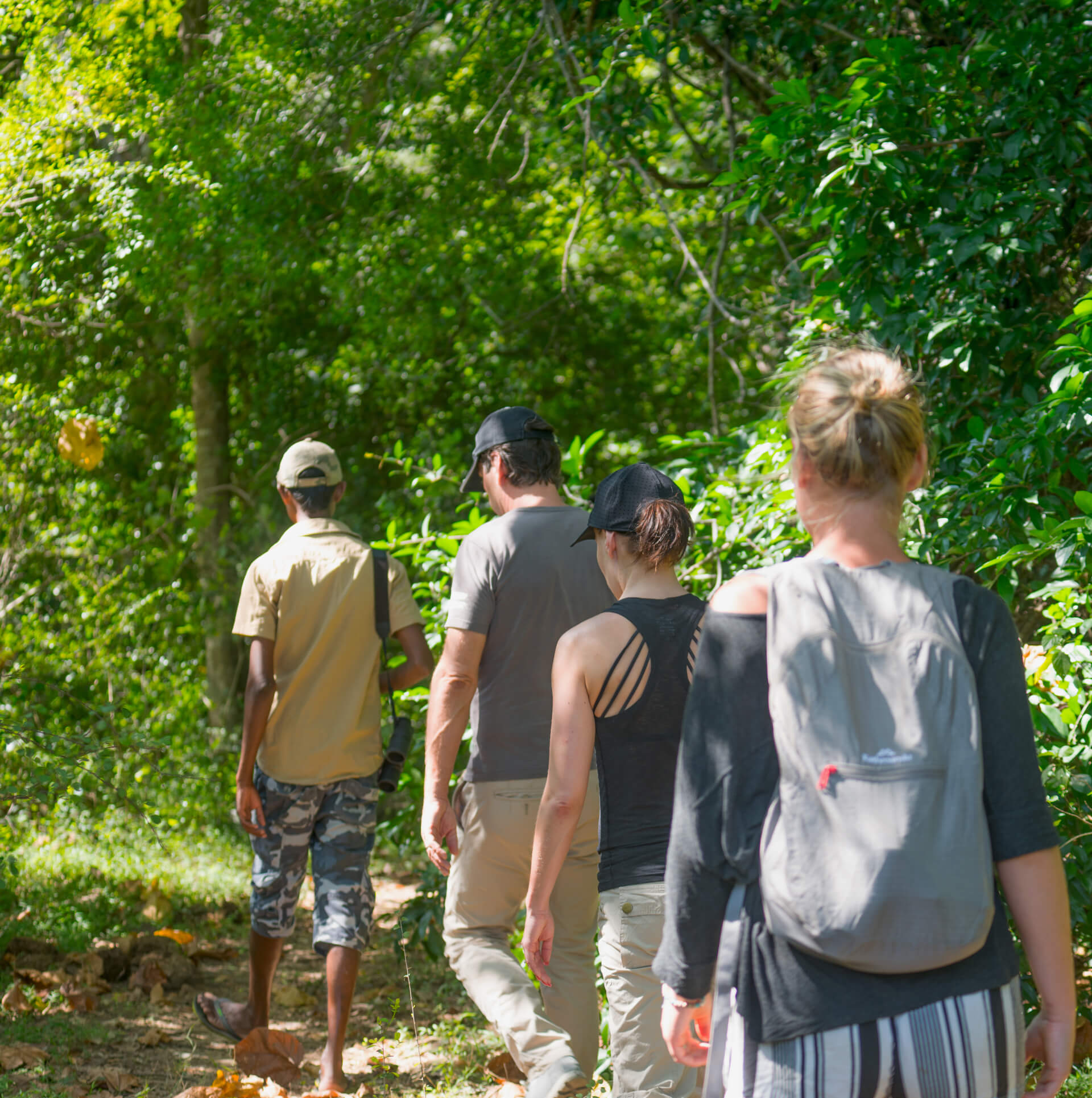
In the Forest
An after breakfast morning walk starts with a 15 minute walk in open bush landscape, then turns into a track inside the dry zone primary canopy forest. The walk inside the jungle is not difficult but may be a little strenuous due to the heat. With a great ecological variety in the area, it is exciting and interesting to explore the biodiversity, fauna and flora. The forest features more than 400 year old ebony trees, magnificent birdlife and a long – but hard to spot – list of wildlife species.
We never know exactly what will happen. Sightings might materialize all of a sudden. On most days there will be good bird sightings. We spot dragonflies, giant squirrels and various lizards. More rarely it occurs that we get a glimpse of elephant, spotted deer, sambar deer, wild boar and monkey. Other rarely observed species are wild buffalo, barking deer, porcupine, jungle cat and fishing cat.
We may pass high places and rocky plateaus in the mountains of the protected Rahatangala conservation forest. You will be rewarded with stunning views of the surrounding countryside, forest, jungle, irrigation tanks and paddy fields. From mountain view points we can see the vast wild landscape of Yala National Park and bordering forests.
Return to camp around 11 – 11.30 am for a big glass of cool, refreshing soda and lime.
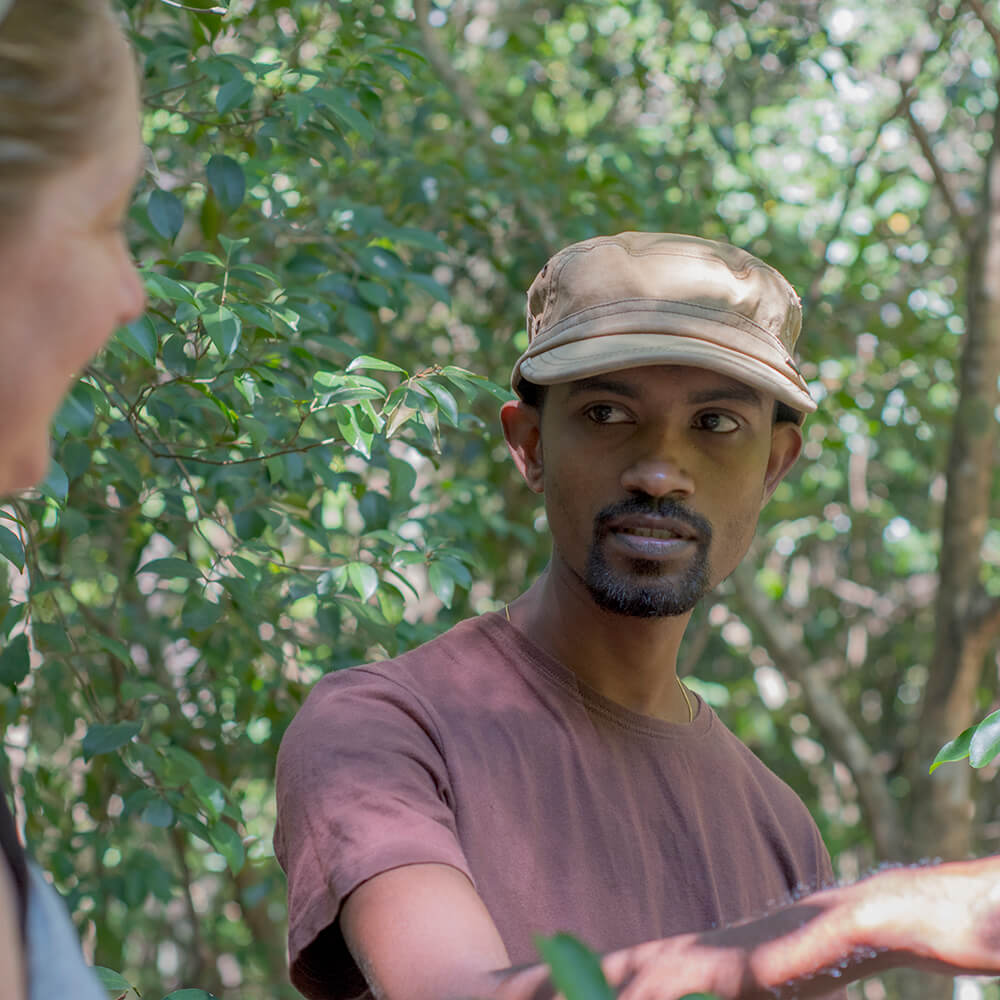
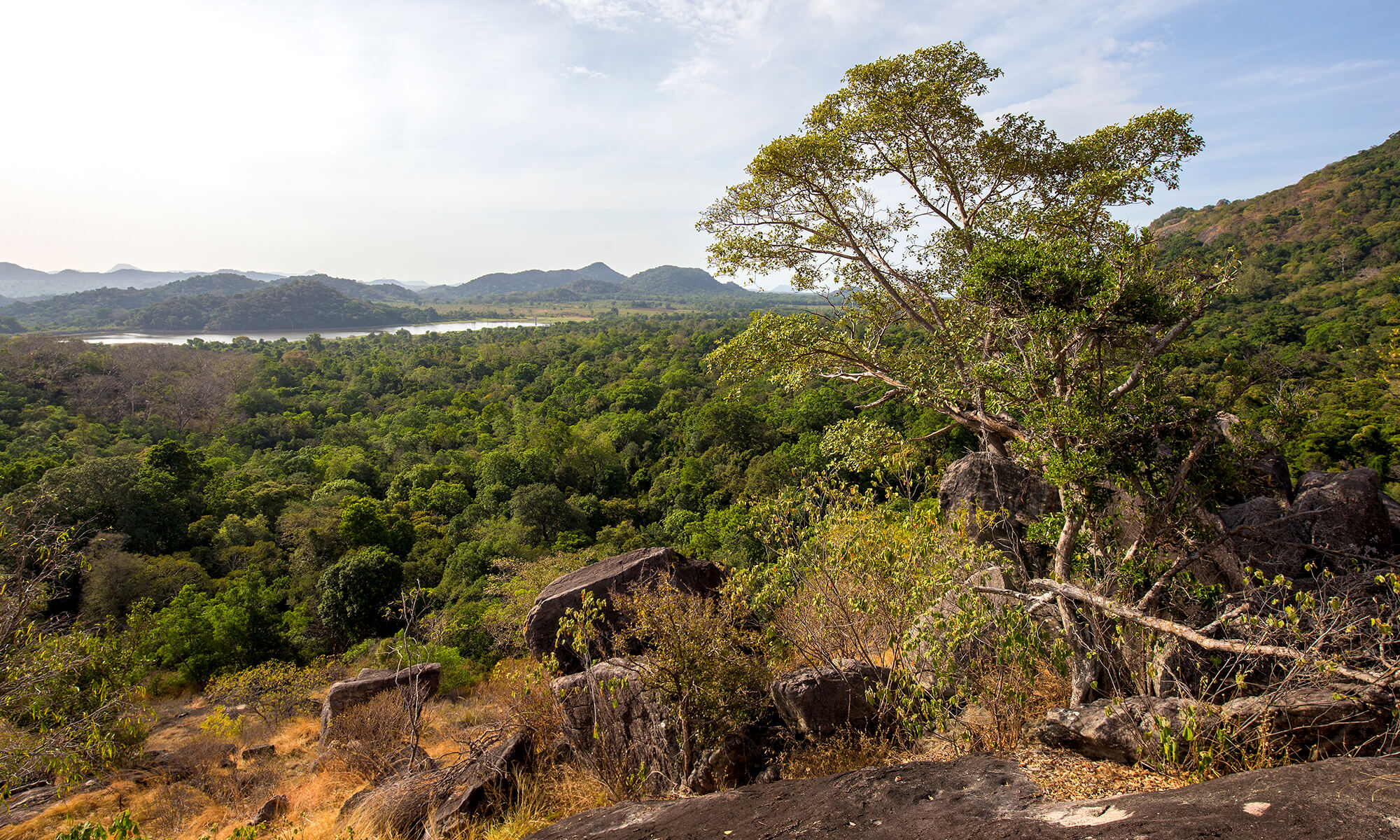
Afternoon Walks
In the afternoon 4.45 pm set off on a 1.5 hours slow walk through bush and abandoned fields and to nearby waterholes. The local area is a mosaic of open wet season farming landscapes, irrigation water holes along the forest, thorny bush jungle and mature tall forest. After the harvest and in the dry season cultivated areas are abandoned and left to be used by animals and birds.
Paddy farmers use the “wewa’s”, the irrigation tanks as a back-up water supply in the cultivating season from October – February. Depending on weather and rainfall farmers also cultivate paddy, some years, in the dry season, using tank water in June and July. The lakes are constructed to catch water running from the boundary of the tall forest. It means the lakes are frequented by birds and by animals, mostly appearing at night.
At lakes we will usually wait for some time. With a bit of luck, wildlife can be observed. Mugger crocodiles could be hiding in the water, maybe catching fish. In dry seasons wild elephants frequently come in the evening to drink water. To see wild elephants you’ll need to wait patiently and behave silently.
Arrive back at the lodge around 6.15 pm in time for a bath and refreshments before the dinner.
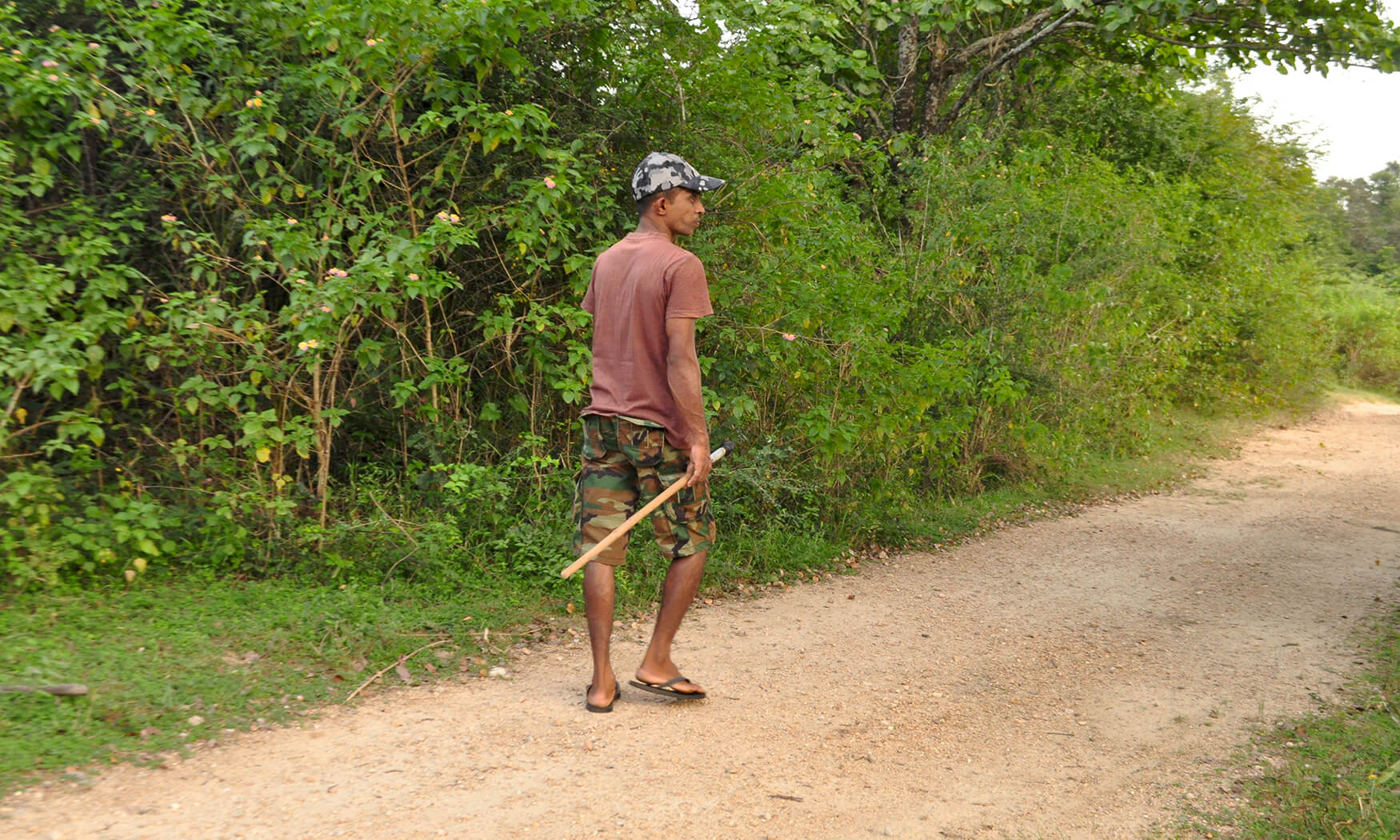
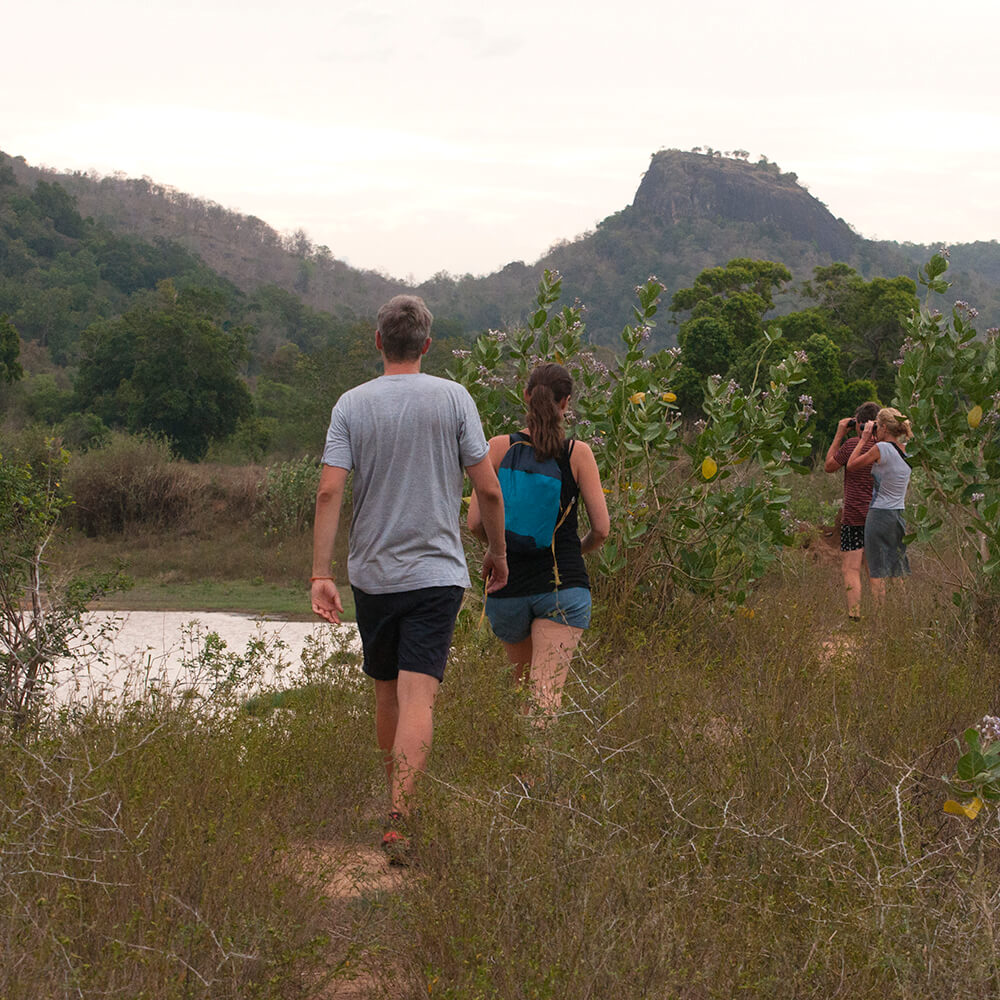
Dry Season
The dry season ( May – October ) offers a special and exciting perspective on the wilderness living experience. This is the period we potentially live amongst wild elephants, sometimes moving around us at the ecolodge property. Or, observed on evening walks at local water holes.
Although not frequent it happens that we decide to return to the camp due to the presence of wild elephants. Walks are always depending on the ‘elephant situation’ … and there is a risk – that you might miss an evening walk … if elephants are around us.
In the drought season from June to September elephants could be around us. If you want to spot them it is regularly an advantage to just stay in our camp. Our ecolodge property is a place elephants can be passing by on their tracks, and we can observe the animals from a safe hiding spot.
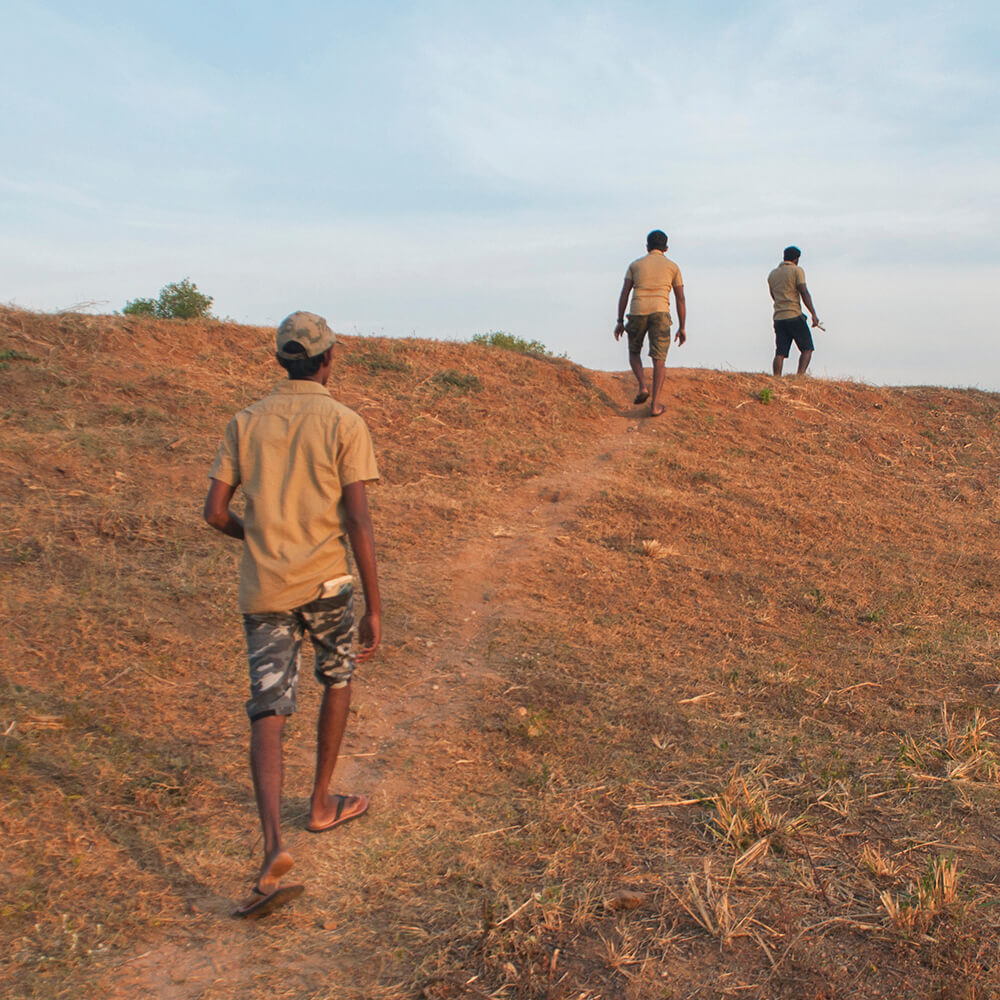

How we plan
In light of safety and risk factors
Our location is wild. Maybe more than guests sometimes believe. On that background there are some safety factors for guests as well as for the staff team to consider when moving around in a wild area.
For that reason it is our policy to refrain from converting local walks to a commercial service. We avoid asking a price for walking with us. No inbuilt walk charge in our rates. The walks with guests are our pleasure. And we make no promises when it comes to walks. We prefer to see what we can do the given day, given the local situation, given the type of guests, given annual, seasonal and periodical variations and changes.


On Foot In the Wild
Any Wildlife Sightings ?
It is better to come with limited expectations to wildlife sightings. Our walks focus on the experience of moving in a wild habitat. The target is not to spot animals. We get the feeling of being in a wild habitat. It is basically exciting. On foot in a habitat of animals.
When we are moving around on foot animal sightings certainly don’t come easy. Wildlife is fearful of humans. They really, really, prefer to avoid seeing two-legged humans approaching them on foot. But our jungle trackers will show their ability to read the marks of the jungle and may even find footprints of elephant, sloth bear and leopard.


In our local landscape. Foot print by a Leopard. A jumping Barking Deer

